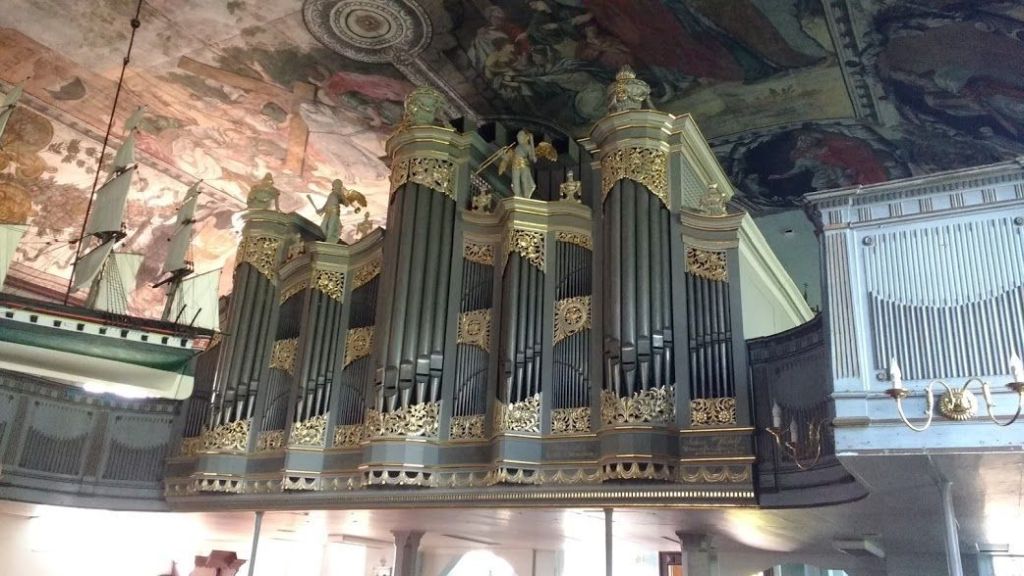Ausführliche Beschreibung der vorgewählten Orgel

Bild: Bert Wisgerhof
Stegna, Polska (Województwo Pomorskie) - Kościół Najświętszego Serca Pana Jezusa
Gemeinde: Stegna
Beschreibung nr.: 2060132.
Gebaut von: Schlag & Söhne (1914) - Opus 1010
Die Orgel enthält älteren Material: Organ case aus 1798 von Friedrich Rudolf Dalitz
The organ in the church of Stegna was built in 1914 by the firm of Schlag & Söhne. The organ case is much older. It was built in 1798 by Friedrich Rudolf Dalitz.
Technische Daten
Disposition
Hauptwerk (C-g'''): Bourdon 16', Prinzipal 8', Gamba 8', Gemshorn 8', Flûte Harmonique 8', Quintatön 8', Gedeckt 8', Octave 4', Rohrflote 4', Rauschquinte 2 fach (2 2/3'), Mixtur 4 fach, Trompete 8'.
Schwellwerk (C-g'''): Lieblich Gedeckt 16', Prinzipal 8', Schalmei 8' - labiaal, Konzertflöte 8', Salicional 8', Portunal 8', Aeoline 8', Vox Coelestis 8', Fugara 4', Traversflöte 4', Flautino 2', Progressiv 2-3 fach, Glockenspiel.
Pedal (C-f'): Prinzipalbass 16', Violon 16', Subbas 16', Gedecktbass 16' - transmissie, Quintbass 10 2/3', Octavbass 8', Violoncello 8', Aeoline 8' - transmissie, Octave 4', Posaune 16'.
Koppeln: Hauptwerk - Schwellwerk, Sub-Octavkoppel Hauptwerk - Schwellwerk, Super-Octavkoppel Hauptwerk - Schwellwerk, Pedal - Hauptwerk, Pedal - Schwellwerk.
Nebenregister und Spielhilfen: 2 freie Kombinationen 2', Tutti, Crescendowalze, Automatisches Pianopedal.
Übrige Quellen

Bild: Bert Wisgerhof
Stegna, Polska (Województwo Pomorskie) - Kościół Najświętszego Serca Pana Jezusa
Gemeinde: Stegna
Beschreibung nr.: 2060132.
Gebaut von: Schlag & Söhne (1914) - Opus 1010
Die Orgel enthält älteren Material: Organ case aus 1798 von Friedrich Rudolf Dalitz
| Jahr | Orgelbauer | Opus | Aktivität | 1798 | Friedrich Rudolf Dalitz | Neubau | 1914 | Schlag & Söhne | 1010 | Neubau im alten Gehäuse |
The organ in the church of Stegna was built in 1914 by the firm of Schlag & Söhne. The organ case is much older. It was built in 1798 by Friedrich Rudolf Dalitz.
Technische Daten
| Anzahl Register pro Manual | |
| - Hauptwerk | 12 |
| - Schwellwerk | 12 |
| - Pedal | 10 (8) |
| Gesamtzahl der Stimmen | 34 (32) |
| Tastentraktur | Pneumatic |
| Registertraktur | Pneumatic |
| Windlade(n) | Cone chests |
Disposition
Hauptwerk (C-g'''): Bourdon 16', Prinzipal 8', Gamba 8', Gemshorn 8', Flûte Harmonique 8', Quintatön 8', Gedeckt 8', Octave 4', Rohrflote 4', Rauschquinte 2 fach (2 2/3'), Mixtur 4 fach, Trompete 8'.
Schwellwerk (C-g'''): Lieblich Gedeckt 16', Prinzipal 8', Schalmei 8' - labiaal, Konzertflöte 8', Salicional 8', Portunal 8', Aeoline 8', Vox Coelestis 8', Fugara 4', Traversflöte 4', Flautino 2', Progressiv 2-3 fach, Glockenspiel.
Pedal (C-f'): Prinzipalbass 16', Violon 16', Subbas 16', Gedecktbass 16' - transmissie, Quintbass 10 2/3', Octavbass 8', Violoncello 8', Aeoline 8' - transmissie, Octave 4', Posaune 16'.
Koppeln: Hauptwerk - Schwellwerk, Sub-Octavkoppel Hauptwerk - Schwellwerk, Super-Octavkoppel Hauptwerk - Schwellwerk, Pedal - Hauptwerk, Pedal - Schwellwerk.
Nebenregister und Spielhilfen: 2 freie Kombinationen 2', Tutti, Crescendowalze, Automatisches Pianopedal.
- Bert Wisgerhof
 |
 |
 |
 |
 |
 |
 |
